“My art addresses my internal tension between my deep love for Nigeria, my country of birth, and my strong appreciation for Western culture, which has profoundly influenced both my life and my art. I use my art as a way to negotiate my seemingly contradictory loyalties to both my cherished Nigerian culture that is currently eroding and to my white American husband. Most of the Nigerian traditions I experienced growing up are quickly disappearing due to the permeation of Western culture and the ensuing opinion that being ”too Nigerian” is uncool. I feel dismayed by Nigerians’ unquestioningly valuing anything Western as superior however, my awareness of this problem does not exempt me from it – indeed, I question whether this mentality played a part in my falling in love with my husband. My art serves as a vehicle through which I explore my conflicted allegiance to two separate cultures.” Njideka Akunyili
Scrolling down my news feed on Facebook this afternoon, I came to an abrupt stop when I saw a posting from my friend Nkiki. It was an image of a black woman with yarn threaded in her hair. The woman was draped along the body of a white man lying on a blue and yellow ankara print fabric. She was kissing his back.
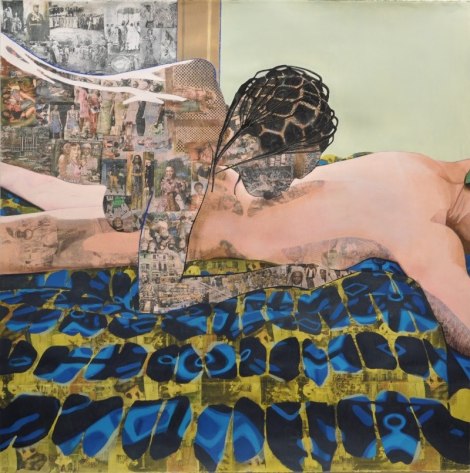
“Thread” by Njideka Akunyili. 2012. Acrylic, charcoal, pastel, color pencils and Xerox transfers on paper. 4.33ft x 4.33ft.
Fascinating, right? Like, you just want to stare it at forever and ever and “wander in wonder” (as my friend Fungai once said). In my normal fashion, I researched like a fanatic and this is what I found.
Njideka Akunyili is a Nigerian artist born in 1983 in Enugu. She lives and works in Brooklyn, New York. She’s a recent MFA Yale University graduate, yet she’s already achieving greatness in the competitive visual arts industry. She was selected for the prestigious Studio Harlem residency program in 2011-2012.
Njideka’s work conveys a love story, between herself and her American husband Justin Crosby (yeah, he’s white). Her creations are quite large in scale and I can understand why — this woman seems to have a lot to say. That’s why her work is bold and multi-layered. If you look closely, you’ll notice lovely details and reflections of Nigeria (the yellow public buses of Lagos called danfu, the faces of her family and friends, popular Nigerian food products, political figures, etc.) I get a sense of nostalgia in her work.
Njideka literally xeroxes (can I use “xerox” in that term?) hundreds of photographs and blends them together. Her 2011 piece, “Efulefu: The Lost One” was a show stopper at The Studio Museum’s “The Bearden Project” exhibition.
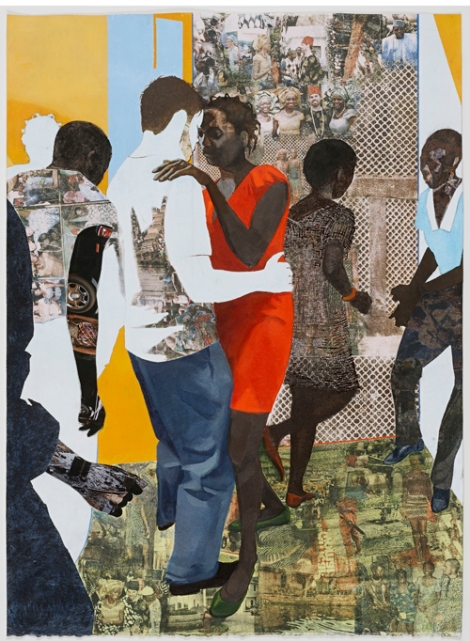
“Efulefu: The Lost One.” by Njideka Akunyili. 2011. Acrylic, charcoal, colored pencil, collage and Xerox transfers on paper
“Efulefu: The Lost One” is an homage to the late Romare Bearden, an experimental and innovative artist who is best known for his richly textured collages. Bearen died in 1988.
Here is what Njideka had to say about Romare Bearden:
“Romare Bearden inspires me because he layered a wealth of information and connotations into each piece without sacrificing—but rather enriching—the work’s overall meaning. I admire his ability to collage together disparate images and spaces into compositions that pulse with such energy and rhythm that they verge on visual cacophony but ultimately come together in harmony. His collages’ busy appearances ring with the lively mood of the Harlem Renaissance. The accuracy with which Bearden expressed the atmosphere of his community in his work serves me as a formative example: I print small images of the Nigeria I have experienced into larger self portraits, thus making a metaphor for my history’s active presence in my daily existence. Romare Bearden’s artwork has been an important influence on me, so I am honored and grateful to have the opportunity to participate in this exhibition and to pay homage to him.”
When I look at Njideka’s work, I fall in love with Nigeria once again. She makes me proud to be Nigerian…an Igbo woman, and…she makes me want to fall in love, because she appears to be so in love with her husband.
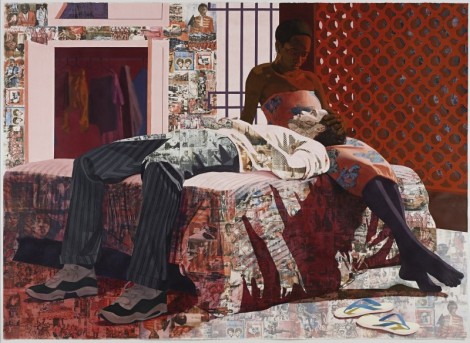
“Nwantinti” by Njideka Akunyili. 2012. Acrylic, charcoal, color pencil, collage and Xerox transfers on paper. 8ft. x 5.5ft.
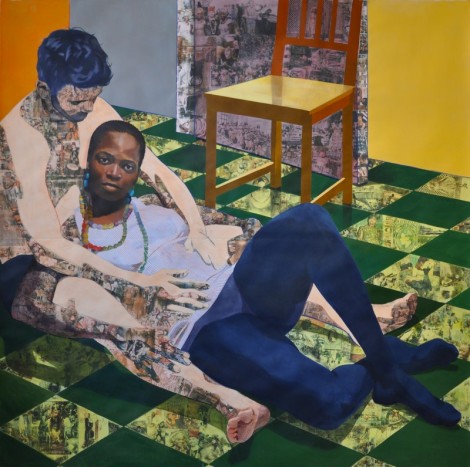
“Cradle Your Conquest” by Njideka Akunyili. 2012. Acrylic, collage, pastel, color pencil and Xerox transfer on paper. 7 ft. x 7 ft.
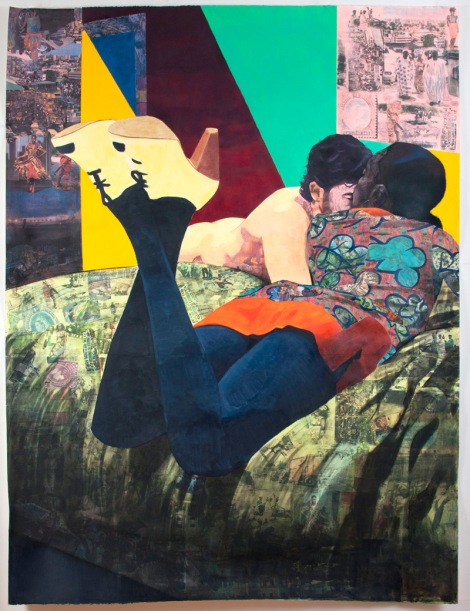
“Her Widening Gyre” by Njideka Akunyili. 2011. Charcoal, acrylic, collage and Xerox transfers on paper. 4.5 ft x 6ft

“Nyado: The Thing Around Her Neck” by Njideka Akunyili. 2011. Charcoal, acrylic, colored pencil, lace, collage and Xerox transfers on paper. 7 ft. x 7 ft.

“The Bridge” by Njideka Akunyili. 2010. Charcoal, ink, acrylic, lace, collage and Xerox transfers on paper. 7ft. x 5 ft.
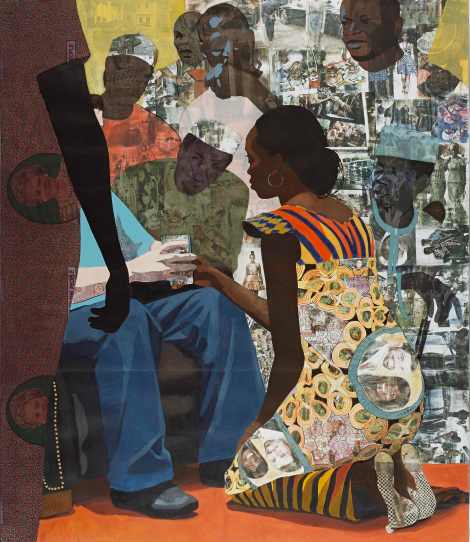
“Wedding Portrait” by Njideka Akunyili. 2012. Acrylic. pastel. color pencils, marble dust, fabric and Xerox transfers on paper. 4.5ft. x 5.25ft.

“I refuse to be invisible” by Njideka Akunyili. 2010. Ink, charcoal, acrylic and Xerox transfers on paper. 7ft. x 10 ft.
Here is an interview with Njideka Akunyili and Bomi Odufunade, featured in Arise Live.
You recently showed a series of five large-scale collage paintings at Art Statements during Art Basel this year. How was your first art fair experience?
It was exciting and overwhelming all at once. Basel is an incredible town and it was absolutely filled with art lovers – artists, curators, critics, collectors, dealers etc. There was a ton of great art on display and it was great to see it all – albeit exhausting.
You once said “My art addresses my internal tension between my deep love for Nigeria, my country of birth, and my strong appreciation for Western culture?” Can you explain what you meant?
The work deals with various themes but the overarching thread is that I’m availing myself of Western painting to seek out a new visual language. In my work disparate elements clash together to give rise to a distinctive yet cohesive whole. The sentence you mentioned refers to an interstitial space of negotiation that I work towards. This in-between/liminal space is referenced a lot in post-colonial discourse – Mary Louise Pratt calls it the ‘contact zone’ and Homi Bhabha calls it the ‘third space’. This transcultural space of constant engagement and appropriation is what I was talking about.
Your paintings combine numerous materials, blending acrylic, charcoal, pastel and pencil with intricate collages. How do you start?
There is no one way I start my work. Sometimes I have a clear idea of the composition. I’ll make sketches, work out the study with ink drawings and plan out the colours in Photoshop. Other times I start with one small area of the drawing and let it grow, introducing various materials when the work needs them.
You are a painter working primarily on paper. What made you lean towards this medium and not the canvas?
I still do work on canvas but most of my work is on paper for various reasons – the foremost being that the soft highly absorbent quality of certain printmaking papers is great for transfers. I also like paper because of the delicacy to it.
How long does it take you to create each collage painting?
It takes about three to four weeks to finish each piece. I can do it in two weeks if I work 17-hour days.
During your residency at Studio Harlem did you face any challenges in the lead up to the exhibition?
The museum has been great and supports you in any way they can. The one limitation I had was that I had to scale down the size of my work because of the lower ceilings in the area where our works were displayed.
Would you say your work to date was self referential?
I’m most invested in a piece when I work from people I know and care about, so there’s a lot of family in my drawings and paintings. The personal narrative part of the work is one of the many layers that make up my studio practice.
Your journey to becoming an artist took a rather interesting route. You originally intended on being a doctor…
I graduated with a double major in Biology and Studio Art. I did art all through college. At the time of graduation I was fairly certain I wanted to be an artist. I ended up going to an MFA program because I wanted a critically intense artistic environment that would make me push and develop my work.
Which artists would you say influenced you in developing your artistic practice?
I look at a lot of painters’ painters like Piero, Titian, Velasquez, Manet, Degas and Balthus, also obscure artists like Hammershøi. For drawing inspiration I admire Holbein and more recently the Italian painter Bronzino because I like the sensuality he achieves with his surface using layers of glaze. I also love Kerry James Marshall, Wangechi Mutu, Malick Sidibé, Nontsikelelo Veleko and Yinka Shonibare. I feel a slight content overlap with the last four artists. Literature coming out of Nigeria and the African diaspora also played a part in the development of my work.
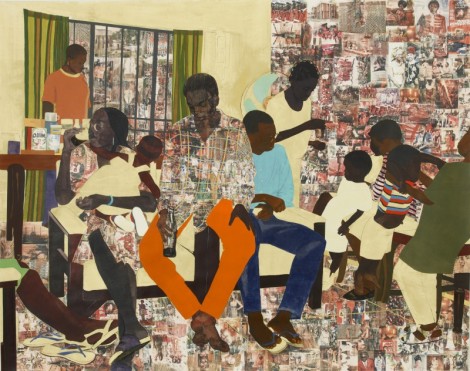
“5 Umezebi St., New Haven, Enugu” by Njideka Akunyili. 2012. Acrylic, charcoal, pastel, color pencil and Xerox transfers on paper. 8.75ft. x 7ft.
Here’s another interview with Njideka Akunyili, as featured on Artistes Only.
AO: Tell me about your technique and why collage is your preferred medium of choice.
NA: My work is a combination of drawing, painting, printmaking and a little bit of collage – most of the smaller
photographic images within each piece are acetone-transferred prints. I use this process in order to layer the disparate materials and images into one cohesive representational scene. Thus, my process of mixing media metaphorically restates the central theme of cultural syncretism in my work.
AO: When did you consider becoming an artist and did this conflict with earlier career ideas ( I ask having known you as a teenager I expected you to become a neurologist, you were great at art but I didn’t expect you to become an artist, not any less than you probably though I’d be a curator)
NA: Just the fact that we are both involved in the arts and are having this dialogue is exciting and proof that more and more Nigerians are pursuing our passions and eschewing the accepted, “respectable” career paths. There were very fixed expectations of us in secondary school – if you were good in sciences, you
became a doctor or an engineer and if you excelled in the humanities, you became a lawyer. Thinking these were my only options, I took pre-med classes throughout my undergraduate studies. I also took a few art classes that made me realise that, contrary to my preconceived perceptions, art could be a deeply engaging, challenging, significant, and powerful endeavour. However, it was not until a year after I graduated that I had the courage to embrace art as a career, despite opposition from my family. I chose to be an artist because I enjoy working in my studio, I feel I have more to contribute to the world as an artist (than as a doctor), and I want to be part of the new crop of Nigerians who challenge the notions of what we can and cannot do.
AO: I liken your work to contemporary artists Mickalene Thomas and Wangechi Mutu. Are these artists people you admire and do you deem these comparisons apt?
NA: I am honoured to be mentioned in the same breath as those two, as I think highly of them and their work. In fact, I sought them out – Mickalene was my core critic at Yale, and Wangechi has become something of a mentor to me – because I thought I could learn a lot from them, which I have. Inasmuch as they have
influenced me and our work deals with some similar concerns, I am unsurprised that you find connections
between my work and theirs.
AO: How do you feel about the works being classified in an Afrocentric/identity art historical theme? I ask because in the same way i am likening your work to a generation of young African-American artists dealing with issues around gender, identity and sexuality. For me your work has a more specific cultural location, in the context of Nigerian culture I can identify with it strongly and I think a lot of people who experience culture clashing in terms of relationships, migration etc. would really identify with your work so in a sense it speaks to a wide audience.
NA: Right! The central focus of my work is an exploration of people’s experience of the space where multiple cultures interact, be that a post-colonial, immigrant, or other scenario. This contact space constantly evolves as its inhabitants balance, appropriate, reject, etc. aspects of the cultures in contact, thereby forming a new hybrid culture. In our more and more globalised world, many people experience such new cultural spaces, so even though my work depicts my specific experiences as a Nigerian who immigrated to America, you are right that the theme addresses a wide audience.
AO:What are your future aspirations and forthcoming projects?
NA: I would like to create a body of work that further examines instances of cultural hybridity by focusing exclusively on the physical spaces in which they transpire. This will be a challenging approach because I customarily rely on the figure to allegorically enact cultural contact – my painted drawings often depict domestic life with my white American husband. I am eager to see what happens when I pursue work that is devoid of the figure and instead relies wholly on the specificity of architectural space. I hope this new body of work will push me to be more deliberate about the structures, furniture and knickknacks I depict in my spaces and in so doing, create a work that elicits a total somatic experience in the viewer.
AO: How does Justin (Njideka’s Husband) feel about featuring so prominently in your work?
NA: Even though he is a somewhat private person, he supports my work and puts it ahead of his desire for privacy. Plus, we are pretty much on the same page in terms of what we are comfortable showing from our personal life. He doesn’t complain much about his presence in the work, but sometimes he gets impatient when I set up poses because I do not always give him clear directions. It’s helpful that he’s also an artist so he gives me good feedback at various stages of the creative process.

“The rest of her remains” by Njideka Akunyili. 2010. Acrylic, charcoal, ink, collage and Xerox transfers on paper.
The depth of her work, I really can’t explain how I feel. It’s just wonderful. Njideka, you are an artist.
Related Content

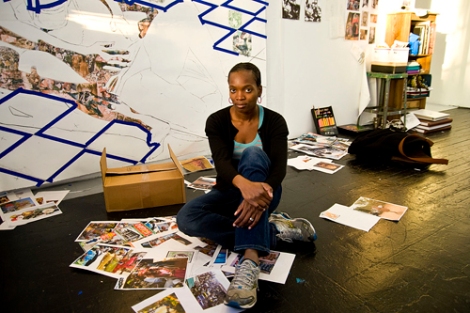
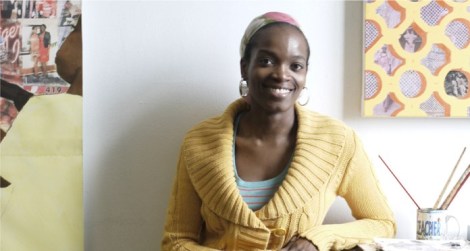
Pingback: La identidad ‘glocal’ y la obra de Njideka Akunyili - Wiriko·
I really like her work-interestingly captivating and ambiguous. keep it up girl.
Are you related to prof. Dora Akunyili of the NAFDAC fame?
Are you related to prof. Dora Akunyili of the NAFDAC fame?
Breathtaking! Lovely talent!
So proud of her. We attended the same high school 🙂
Pingback: “I feel like I’m taking this Western visual language I inherited, just as African writers inherited English, and I’m trying to make a new version of it so it speaks to another place.” – STRANGE GRAVITY·
Pingback: “My work is not about being a Nigerian living in America.” – STRANGE GRAVITY·
Pingback: Njideka Akunyili Crosby – Beyond the Single Story·